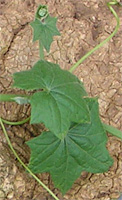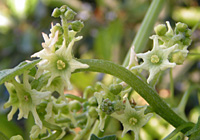

Fabaceus leaves, tendrils,
and a young shoot against
the exposed tuber.
Marah fabaceus is also called California Manroot. Fitting its stately name, M. fabaceus grows throughout California where it can often be found twining alongside its more geographically restricted sister species. A highly variable plant, M. fabaceus has two recognized subspecies, fabaceus and agrestis. Subspecies fabaceus is generally confined to the lands around San Fransisco Bay. Subspecies agrestis includes all plants outside the SF Bay area.
In general, M. fabaceus has the most polygonal leaves of Marah. That is to say, the general shape and lobing of its leaves are composed of straight sides with short apex points. Stems and leaves of marah fabaceus are lightly pubescent although plants from dryer areas will often show greater density of hairs.

Unripened fruit.
Flowers can be from white to light green and have thin petals which curl along the long axis giving the flower a slightly contorted look. Male flowers have short stems and are held parallel to the main bloomstem (similar to the manner of hollyhocks). Female flowers hang down from the base of the male bloomstem and have an embryonic fruit swelling at the base of their short stem.

Male flower clusters.
Jepson Manual Treatment »
Calphotos Images »


